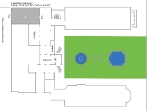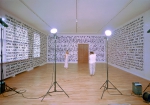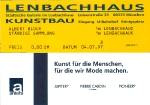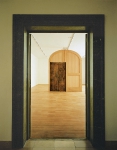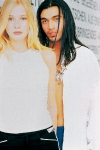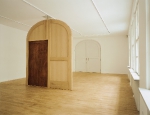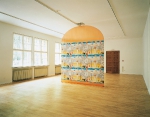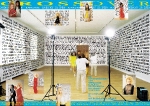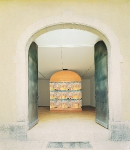Michael Hofstetter, The Threshold, 1997
Lenbachhaus München
Michael Hofstetter: Threshold: Lenbachhaus
Essay: Thomas Dreher / Translation: Paul Bowman
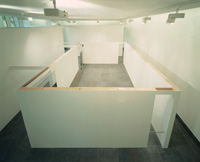 Away from Everything / All Powerful, 1994, intervention in the Haus der Kunst, MunichAccording to a conception (still) paradigmatic in the art context, works are isolated objects presented in front of neutral backgrounds, quintessentially a space with white walls. In such a space created for the presentation of isolated objects, an artist can realise an installation that integrates the surrounding space into the work whilst problematizing, along with the given circumstances, the established work concept. An art seeking to embed itself in a pre-existing context, not in the sense of assimilating but rather aiming to criticize the given, can – if the context is that of a museum – create a model situation that simultaneously investigates the conception of art underlying this space’s configuration; and conversely: together with an art concept, this work can explore its consequences for configuring exhibition spaces. An installation only temporarily embedded in a built manifestation of a conception of art can, by supplementing the surrounding space, furnish opportunities to reflect on the postulates of art conceptions and the premises underpinning presentations in exhibition spaces: the supplement gives rise to discourses about the supplemented, while the periphery and the ephemeral move us to ponder what is taken as the currently valid and what is permanently built.
Away from Everything / All Powerful, 1994, intervention in the Haus der Kunst, MunichAccording to a conception (still) paradigmatic in the art context, works are isolated objects presented in front of neutral backgrounds, quintessentially a space with white walls. In such a space created for the presentation of isolated objects, an artist can realise an installation that integrates the surrounding space into the work whilst problematizing, along with the given circumstances, the established work concept. An art seeking to embed itself in a pre-existing context, not in the sense of assimilating but rather aiming to criticize the given, can – if the context is that of a museum – create a model situation that simultaneously investigates the conception of art underlying this space’s configuration; and conversely: together with an art concept, this work can explore its consequences for configuring exhibition spaces. An installation only temporarily embedded in a built manifestation of a conception of art can, by supplementing the surrounding space, furnish opportunities to reflect on the postulates of art conceptions and the premises underpinning presentations in exhibition spaces: the supplement gives rise to discourses about the supplemented, while the periphery and the ephemeral move us to ponder what is taken as the currently valid and what is permanently built. 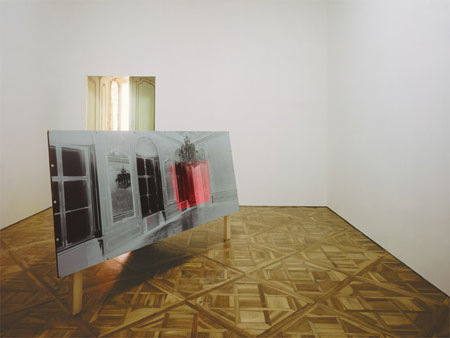 To Make A Haul 1996, site specific intervention in the museum Johanneum GrazAn installation is spatially part of an art context, but on the semantic level it can point to aspects of art discourses (art criticism, art theory, artist theory) about works of art and their context (the institution of art/the art world), provoke and also explicate critique. Semantic elements provoking or explicating reflection, like texts and images, can be distributed in such a way that the semantic and spatial levels reciprocally illuminate one another.
To Make A Haul 1996, site specific intervention in the museum Johanneum GrazAn installation is spatially part of an art context, but on the semantic level it can point to aspects of art discourses (art criticism, art theory, artist theory) about works of art and their context (the institution of art/the art world), provoke and also explicate critique. Semantic elements provoking or explicating reflection, like texts and images, can be distributed in such a way that the semantic and spatial levels reciprocally illuminate one another.
Art problematizing the circumstances of its own presentation has to first accept the given surrounding space as the prerequisite of its own strategy of critical self-embedment before it can proceed to reveal this basis as constrictive: a break with the given circumstances is ruled out if its very own prerequisites are not to be eliminated by destruction or affirmed via negation – for there is no negation that is not without affirmation due to the necessary referring to the negated. 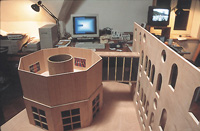 Four Plus Four 1997, indexical field consisting of autonomous artworks; Galerie Stadt Sindelfingen Faut Raisonnement Fait de Bonne Foi 1989; The Passage 1997; One's Own Four Walls 1997; exhibition modelThe alternative to destruction and negation are strategies which generate shifts in the encountered structure made up of interlocked spatial and semantic levels.
Four Plus Four 1997, indexical field consisting of autonomous artworks; Galerie Stadt Sindelfingen Faut Raisonnement Fait de Bonne Foi 1989; The Passage 1997; One's Own Four Walls 1997; exhibition modelThe alternative to destruction and negation are strategies which generate shifts in the encountered structure made up of interlocked spatial and semantic levels.
Michael Hofstetter has created context-related installations in a museum context in a way that problematizes the self-embedment in the context: in 1994 in Haus der Kunst, 1996 in Graz’s Palais Heberstein, and in 1997 first in the Galerie der Stadt Sindelfingen and then later in Munich’s Lenbachhaus.(1) As a model of observing a surrounding space, presented at the very site of this observation, The Threshold in the Municipal Gallery in Lenbachhaus reveals itself to be context-related and context-reflective art in context.
(1) Von allem entfernt/Alles beherrschend, Haus der Kunst, Munich, 1994, in: Hofstetter, Michael: Das Fortschreiben der Umstände 1990-1995, n.p. 1995, pp. 106-113. Beutemachen, Neue Galerie, Palais Herberstein, 1996, in: Fenz, Werner/Braun, Reinhard (eds.): Radikale Bilder, Österreichische Triennale zur Fotografie, cat. Neue Galerie am Landesmuseum Joanneum und Künstlerhaus, Graz 1996, vol.2, pp.44f.
Vier + Vier, Galerie Stadt Sindelfingen, 1997, in: Pannewitz, Otto (ed.): 20 Jahre Kunststiftung Baden-Württemberg. Mediale Welten – 6 Stipendiaten stellen aus, cat. Galerie Stadt Sindelfingen. Sindelfingen 1997, pp. 32-41.
Hofstetter installs The Threshold in an exhibition room of the Lenbachhaus the visitor can enter from a wide hallway, after passing the museum ticket counter, the museum shop and café. 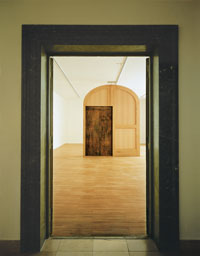 The Threshold 1997, site specific installation at the Lenbachhaus, MunichFrom the hallway, visitors look through an open door into the exhibition room and onto a wall, in the shape of a gate, erected in the middle of the room. As soon as visitors enter the room and reach the point that they are able to gain a glimpse of the space otherwise covered by the installed wall, they see a gate in the rear wall and can now recognise that the measurements and forms of the wooden parts of this gate, which itself serves the transportation of exhibition items in and out of the museum, are replicated by Hofstetter in the installed wall. The gate-shaped wall – as a threshold we can circumvent – and the closed rear gateway correspond: as byway and non-gateway. Upon leaving the exhibition rooms of the Lenbachhaus, the visitor can then see the exterior of the rear gate from Richard-Wagner-Straße: The Threshold in Lenbachhaus shows this art museum to be an interior/exterior “threshold” between very different public spaces: the installation reveals the museum context to be one of the breakages of public space into “heterotopias”.(2)
The Threshold 1997, site specific installation at the Lenbachhaus, MunichFrom the hallway, visitors look through an open door into the exhibition room and onto a wall, in the shape of a gate, erected in the middle of the room. As soon as visitors enter the room and reach the point that they are able to gain a glimpse of the space otherwise covered by the installed wall, they see a gate in the rear wall and can now recognise that the measurements and forms of the wooden parts of this gate, which itself serves the transportation of exhibition items in and out of the museum, are replicated by Hofstetter in the installed wall. The gate-shaped wall – as a threshold we can circumvent – and the closed rear gateway correspond: as byway and non-gateway. Upon leaving the exhibition rooms of the Lenbachhaus, the visitor can then see the exterior of the rear gate from Richard-Wagner-Straße: The Threshold in Lenbachhaus shows this art museum to be an interior/exterior “threshold” between very different public spaces: the installation reveals the museum context to be one of the breakages of public space into “heterotopias”.(2)
(2) Foucault, Michel: Andere Räume. In: Hämer, Hardt-Waldherr/Kleihues, Josef Paul (ed.): Idee Prozeß Ergebnis. Die Reparatur und Rekonstruktion der Stadt, cat. Martin-Gropius-Bau. Berlin 1984, pp. 337-340.
Visitors are ushered into the installation in such a way that they first see the replication concealing the replicated. In his La Condition Humaine(3) René Magritte had a painting-within-a-painting, as the representation of a representation, take the place of a representation and what it represents; in The Threshold however, the replica only covers the original when viewed from a specific standpoint. Magritte envisions the connection between a representation and the represented as a relation: between a represented that is absent and a representation that is present, albeit, in the painting-within-a-painting embedment, this representation itself fractures into an image, one that is both present and absent/concealed. In contrast, Hofstetter refers to the present replicated through the replica. Installations of context art bring forth once again – or re-produce – direct connections to objects and situations in the surrounding space; however this, 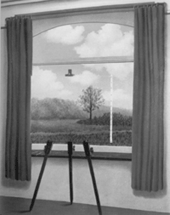 René Magritte, La Condition Humaine, 1933 after Magritte, and so too unavoidable for Hofstetter, cannot occur without reflecting on the problem of the absent origin, the “originary trace”,(4) on the level of the text and image semantics. Because the elements referring to reality – as forms of a fixed and variously culturally and socially prejudiced architectural vocabulary – are also pre-coded, then the real referent in the exhibition context can also be problematized as a reproduced pattern with mostly dubious or no longer determinable origin: the form vocabulary of the ‘original’ of the gate replica is itself already the result of a chain of replicas, with and without variations.
René Magritte, La Condition Humaine, 1933 after Magritte, and so too unavoidable for Hofstetter, cannot occur without reflecting on the problem of the absent origin, the “originary trace”,(4) on the level of the text and image semantics. Because the elements referring to reality – as forms of a fixed and variously culturally and socially prejudiced architectural vocabulary – are also pre-coded, then the real referent in the exhibition context can also be problematized as a reproduced pattern with mostly dubious or no longer determinable origin: the form vocabulary of the ‘original’ of the gate replica is itself already the result of a chain of replicas, with and without variations.
(3) Magritte, René: La Condition Humaine I, 1933, oil on canvas, in: Schneede, Uwe M.: René Magritte. Leben und Werk. Cologne 1978, 3rd edition, pp. 49ff., 83, colour reproduction 3. Cf. Magritte, René: Sämtliche Briefe. Frankfurt a.M. 1985, p.108.
(4) Derrida, Jacques: Grammatologie. Frankfurt a.M. 1974 (original: De la grammatologie. Paris 1967), p.107, cf. p.113f.
Inserted in a segment of the replica gate is a dark brown rectangle. Its (by the means of urine) oxidised copper(5) finish refers to the weather-exposed metal on the gate exterior and the scale of the passageway through the museum interior. That behind the wooden parts of the replica gate a layer of copper plates stretches across the whole area of the installed wall, is revealed at its narrow sides. The copper layer of The Threshold is made of several plates, the size of which – for practical reasons – do not correspond to the dimensions of the copper parts of the finish on the gate exterior. The joints between the copper plates, visible in the cut out in the replication of the gate interior, add a new measurement system, one not prescribed by the museum architecture.
(5) Cf. Warhol, Andy: Oxydation Paintings, 1978, mixed technique (urine) on copper metallic pigment (synthetic acrylic and metallic powder) on canvas, in: McShine, Kynaston (ed.): Andy Warhol. Retrospective. Cat. Museum Ludwig. Cologne 1989, pp. 19, 72, 346f., 414.
In his installation Hofstetter interlaces parts of the surrounding space, whereby the context-internal boundaries of the observer situation are addressed as a theme through internalising the external: the wall installed in the museum replicates a material (state) from the gate’s exterior in a segment inserted in the replica of the forms of the gate interior. The format in this segment matches the museum’s internal entry to the installation space. Materials, state, mass and forms from the surrounding space are taken up by the installed wall, not exactly equally, but repeated similarly and combined in a way altering how the relationships in the surrounding space are observed.
The installation prompts the observer into reconstructing its model-like (and along with it his/her own) placement, at once in both the work and museum context: through the manner of its contextual relationships the installed wall ruptures its own position on the interior of the art museum at its own exterior – and this by folding parts of the exterior inward. The internalised external functions as a “self-reference interrupter” (6): art is neither translated into the life-world, nor strictly excluded from it; rather, the self-referencing of art is ruptured through the extrinsic references external to art: self (self/other). (7)
(6) Junge, Kay: Medien als Selbstreferenzunterbrecher. In: Baecker, Dirk (ed.): Kalkül der Form. Frankfurt a.M. 1993, pp.112-151.
(7) Dreher, Thomas: Peter Weibel - Polykontexturalität in reaktiver Medienkunst...In: Schuler, Romana (ed.): Peter Weibel. Bildwelten 1982-1996. Vienna 1996, pp. 38f., 48.
In pursuing his strategy of self-embedment in a museum context, Hofstetter deploys the pre-existing deviations from the ideal of white exhibition walls, i.e. the interruptions through the door and gate. An art problematizing – through context references – its own location has three alternatives in the museum-specific “white cube” (8): either the architecture formed by the white wall is repeated through installed walls in the exhibition space; or qualities of the context-specific disruptions of the neutrality of the “white cube” are taken up; or a sub-complex, in itself less attractive object is placed to interrupt this neutrality, which can result in reciprocal references between interrupter and interrupted, cancelling out the neutrality of both. The latter alternative corresponds to a practice common since Minimal Art – to create references arousing interest less so through relations between parts of the object, and turning instead to its integration into its surrounding space. For Hofstetter though, this alternative is not an option because it does not enable an interlocking of semantic and spatial references. In remote from everything/domineering all in Munich’s Haus der Kunst, Hofstetter decided for replicas of characteristics of museum practice, repeating the walls of a pre-existing room in miniaturised scale, whereas in The Threshold he gives preference to references to site-specific disruptions of the neutrality. As an installation, The Threshold points out that the ideal of the ‘white cube’ can only be realised when the function-specific deviations from neutrality are integrated and concealed: to make it possible to tangibly experience objects without distraction, museum practice simulates neutrality by concealing the gate for example.(9)
(8) O’Doherty, Brian: Inside the White Cube. Notes on the Gallery Space. Part I. In: Artforum. March 1976, pp. 24-30.
(9) In his concept for Lines Connecting Architectural Points from 1970, Sol LeWitt used interruptions in the white wall as pre-existing points which were then to be joined together: “All architectural points connected by straight lines”. (Legg, Alicia (ed.): Sol LeWitt. Cat. Museum of Modern Art. New York 1978, p. 114, fig. p. 181f.; LeWitt, Sol: All Wall Drawings. In: Arts Magazine. February 1972, p. 41 (quote), fig. p. 54f.) From interruptions LeWitt crafts an approach for creating forms of surprising forms for wall drawings, whereas Hofstetter problematizes the difference between canonised museum presentation settings and the installation.
In “Beutemachen” in the Red Hall of Graz’s Palais Herberstein, Hofstetter problematizes the white walls installed in the Rococo interior (by Heimo Zobernig) by blending in a silk screen with a photograph of the concealed identical wall segments from the Yellow Hall in a state not ‘estranged’ by the needs of museological practice. Here, too, Hofstetter is concerned with pointing out the difficulties of maintaining a building structure (and so museifying it) and at the same time adapting it to fit museum purposes in the sense of the white cube.
On the side of the installed wall facing away from the entrance for museum visitors and facing towards Richard-Wagner-Straße, six photographic reproductions of an image are to be seen. This image shows texts on walls. Unlike the real installation location, the text installation carried out in the very same space was never accessible to the public. The image shows three walls with one text that, covering the windows, is only interrupted by the door, shown to be closed. While the observer of the image of the text installation is given no other standpoint in the photographed space than that of the camera angle, the cameraman is nevertheless to be seen in two further positions: the change of the cameraman’s location in the image runs counter to the ideal location, signified by the vanishing lines.
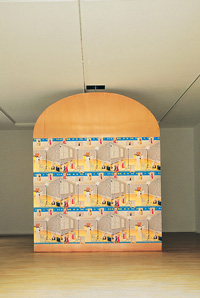 The Threshold, 1997, site specific installation at the Lenbachhaus, MunichThe image space shows a possible artistic configuring and occupying of the walls of the real space that leaves the installation uninterrupted and white. The artistic configuring and occupying of the walls as a text space is only three-sided in the image space, similar to a stage area: because the observer in the installation can look at an image of the installation location from the best standpoint, and thus like someone attending a feudal theatre observes the goings-on in a proscenium stage from an ideal standpoint in the spectator stands, (10) to where all the vanishing lines of the stage architecture merge, then the difference to the observer situation in classical theatre becomes palpable – the stage setting in The Threshold is not that of a fictive space representing a different place, but rather an image of the real space, as it is behind the image. In The Threshold the observer adopts a dual – both internal and external – standpoint in relation to the real space, whereby the standpoint of an observer of the “Crossover” poster, external to the image, is embedded in the real space which can be seen in the image.
The Threshold, 1997, site specific installation at the Lenbachhaus, MunichThe image space shows a possible artistic configuring and occupying of the walls of the real space that leaves the installation uninterrupted and white. The artistic configuring and occupying of the walls as a text space is only three-sided in the image space, similar to a stage area: because the observer in the installation can look at an image of the installation location from the best standpoint, and thus like someone attending a feudal theatre observes the goings-on in a proscenium stage from an ideal standpoint in the spectator stands, (10) to where all the vanishing lines of the stage architecture merge, then the difference to the observer situation in classical theatre becomes palpable – the stage setting in The Threshold is not that of a fictive space representing a different place, but rather an image of the real space, as it is behind the image. In The Threshold the observer adopts a dual – both internal and external – standpoint in relation to the real space, whereby the standpoint of an observer of the “Crossover” poster, external to the image, is embedded in the real space which can be seen in the image.
(10) Graham, Dan: Theater, Cinema, Power. In: Parachute. Juin-Juillet/Août 1983, pp. 11f.
The boundary/interface between enterable real space and non-enterable image space constitutes a “threshold” on and in the installed wall, which forms a “threshold” that can be bypassed. The two “thresholds” display different qualities: that in the real space which can be passed by and does not assign the observer a standpoint; and that which faces the simulation of the image space, implying an ideal observer standpoint outside the simulation. While for the image space the distortions of the perspective are constitutive, for the readability of the texts they are peripheral, irritating at the most. Blended into the image space and thus also into the real space, the text provokes a questioning of the discourse on art that supplies semantic fields to art museums and thus the site of the installation. The fragments gleaned from discourses on art prompt us to comprehend the visual and spatial experience not as direct, but as mediated via perceptual and intellectual / discursive / text “schemata”.(11) Hofstetter places the problematic broached above with Magritte – the presence/absence in the real referent – and the installation containing real referents as well as reproductions above the question as to how we observe what is real, and answers it by revealing that the concepts of reality held by the observer are the very basis for what is observable.
(11) Lenk, Hans: Schemaspiele. Über Schemainterpretationen und Interpretationskonstrukte. Frankfurt a.M. 1995, pp. 27, 29, 34, 51; Luhmann, Niklas: Die Gesellschaft der Gesellschaft. Frankfurt a.M. 1997, p.144. According to Ernst von Glasersfeld, the “empirical abstraction” is linked back to the conceptual reorganisation of ideas of “object permanence” in “reflective abstraction” (idem: Radikaler Konstruktivismus. Ideen, Ergebnisse, Probleme. Frankfurt a.M. 1996, (English original: Radical Constructivism. A Way of Knowing and Learning. London 1995), pp. 144f., 173-176, 194f.), i.e. developments in perceptual “schemata” are linked back to thought “schemata”.
The lines of text in the image space are quotes Hofstetter has selected from a collection of artist statements put together in Wegweiser: Kunst für München im öffentlichen Raum 1972-1997, the majority already published, in some cases republished. Hofstetter keeps the same sequence of the statements as in Wegweiser, which had arranged them alphabetically based on the artist’s name; he does however refrain from naming the authors.
In the statements the artists mostly explain characteristics of their oeuvre instead of explicating the project realised for a public or semiprivate location in Munich, both indoors and outdoors, and which is illustrated in Wegweiser. When the works and statements were made differ greatly in some cases. Many statements are too unspecific for a precise definition of the characteristics of an oeuvre, a work phase or a single work; it is thus the photographic reproductions of the works which provide ideas and suggestions for deciphering the meaning of the statements rather than the other way around.
Without any reference to either artist or work, the quotes selected by Hofstetter accumulate into a chain of discourse fragments which relate to the sculptural or the painterly as well as to the arbitrary or to rules. The discourse fragments provide information on the characteristic features of the discourses of artists commissioned to complete site-specific works in Munich: the adopted traditions of the genres of painting and sculpture are not questioned, but rather random single aspects are frequently picked out and used for self-portrayals. While some of the discourse fragments in the text space quote artistic statements emphasising the autonomy of art and its relationship to the world, the quoting itself is not conducive to extrapolating a coherent artistic concept: they are exchangeable utterances taken from theories by artists, limited to statements delivered in a given discursive framework.(12)
(12) Anyone doubting that this critique is not directed at Lawrence Weiner’s statement, first published in 1969, later modified and once again quoted in Wegweiser (known by the author in a version from 1979 [Rorimer Anne: 73rd American Exhibition. Cat. The Art Institute of Chicago. Chicago 1979] and in later reiterations, but which Wegweiser quotes from a 1994 publication and gives as the original source date) fails to take into consideration genre postulates because it is contradicted by Art & Language in “Status and priority” (Studio International. January 1970, p. 28f.).
The question is justified if Hofstetter is not himself first provoking the impression described here through the selection of sentences and phrases from the artist statements. The profiling edit reveals and in revealing changes the revealed. Hofstetter then shows what was cut out and what pruned away in the catalogue to The Threshold.
The text space reproduced in The Threshold puts the problem of authorship on hold and emphasises the problems of the “dispositif” (13) of the artist discourse, the discursive formations recurring in many artistic statements but precisely therefore not yet conclusive. Only in a conceptual turn as the one completed by members of the artist group Art & Language in 1966, can a transformation of the discourse formation of random internal breakages of established artistic strategies take place: Art & Language (14) presented, as a text-work itself instead of as some appendage, new approaches to art theory and new modes of critique of established theoretical positions at sites deemed suitable for presenting established art genres (painting, sculpture, drawing and prints). In his installation of a text space, Hofstetter is once again taking up the conceptual approach of integrating the discourse on art into the presentation form, envisioning however not a meta discourse but a model assembled out of text finds that provokes reflection. Joseph Kosuth, in whose oeuvre the relationship concept/context is assigned a key role, deploys in installations with wall texts text finds as elements of a (polyphonic fractured) meta discourse (15); The Threshold deploys its text finds to induce reflective considerations prompting critique.
(13) Deleuze, Gilles: What is a dispositif? In: Armstrong, Timothy J. (ed.): Michel Foucault. Philosopher. New York 1992, pp. 159-168 ; Foucault, Michel: Dispositive der Macht. Über Sexualität, Wissen und Wahrheit (Interviews). Berlin 1978, pp. 119-125.
(14) Dreher, Thomas: Art & Language. Kontextreflexive Kunst im Kunstkontext. In: Institut für soziale Gegenwartsfragen, Freiburg i.Br./Kunstraum Vienna (ed.): Art & Language & Luhmann. Vienna 1997, pp. 43-56; idem.: Konzeptuelle Kunst in Amerika und England zwischen 1963 und 1976. Frankfurt a.M. 1992, pp.24f., 295-302, fig.18.
(15) E.g. Kosuth, Joseph: The Play of the Unmentionable. London 1992.
Thanks to the choice of the contextual references and ‘how’ the referential elements are combined, a position can be discerned and distilled from the installation The Threshold: Hofstetter problematizes the relationship between artist theory, art practice and their institutionalisation, and does so by amalgamating different aspects of this relationship in the installation on the spatial and semantic levels. Against the background of the presentation forms Hofstetter himself employs, the strategy of demonstrating the conflicts resident in the paradigms of art production and the art scene suggests that a paradigm change is being eschewed in favour of a “paradigm-shift-from”, (16) while normative aesthetics such as genre postulates are being replaced by intermedia strategies, by open combinations of media from provenances both extrinsic and intrinsic to art, whereby these combinations cannot themselves be standardised or again fixated into genres. The form the media usage takes on is only relevant to the extent that it is capable of initiating possibilities of reading which serve as a model for observing art and the world. The model presents differentiations of modes of observation for art and world as reciprocal internal/external ruptures, but refrains from specifying any conceptualisation of this differentiation process into a thought model.
(16) Atkinson, Terry/Baldwin, Michael: Some post-war American work and Art-Language: ideological responsiveness. In: Studio International. April 1972, pp. 164-167.
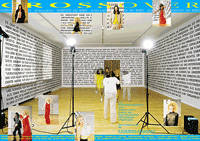 The Threshold, 1997, site specific installation at the Lenbachhaus, Munich; PosterThe photo of the text space also shows, in multiple exposure, a photo session with models and photographer moving around. Hofstetter presents the reproduction of the text space with fashion performances as a poster announcing a fictive symposium entitled Cross Over: Art & Fashion. Intention and Event, whereby the subtitle provides a motto: “Regaining reality through the multiplication of fictional strategies”.
The Threshold, 1997, site specific installation at the Lenbachhaus, Munich; PosterThe photo of the text space also shows, in multiple exposure, a photo session with models and photographer moving around. Hofstetter presents the reproduction of the text space with fashion performances as a poster announcing a fictive symposium entitled Cross Over: Art & Fashion. Intention and Event, whereby the subtitle provides a motto: “Regaining reality through the multiplication of fictional strategies”.
Fashion and art context appear less as counter models to one another and more as complements, for both start from pre-coded fundamental understandings which have hardly changed over the last few decades. Photos of models in striking clothes and poses (17) are blended into the photo of the text space as if they were actors playing the roles of speakers at a symposium: fictive authors with seemingly individual exteriors which are, in reality, assembled out of pre-made and -coded elements.(18) Clothing and text codes appear to be parts of discourse formations which have severed the connections to the very authors involved in their development or have lost these connections in a textured fabric out of correlations, ever dissolving and re-correlating.
(17) The clothes are by Carolyn Quarterman. The golden texts on the red and black clothes worn by the models on the right of the poster quote wine labels.
Hofstetter names the artist Vanessa Beecroft as taking part in the symposium; in her performances Beecroft at once uses and satirises elements from fashion shows (Coles, Sadie/Meyer-Hermann, Eva (ed.): Ein Stück vom Himmel. Cat. Kunsthalle Nürnberg 1977, p.49f.). Beecroft is mentioned after David Bailey, who since the 1970s has photographed concerts and contributed to stylising musicians into rock legends (Rolling Stones, Beatles etc.; Bailey, David: Rock and Roll Heroes. Munich 1997). Allusions to music, art and fashion performance are verified by the motto: “Regaining reality through the multiplication of fictional strategies”. The selected authors attending the symposium would undoubtedly appeal to anyone active and interested in the field of fashion and design due to the overlapping semantic fields; a closer look though reveals that there is no real coherent concept.
(18) The authors/speakers at symposia and artists share a problem: selecting a form of self-representation that is locatable for the audience and can hook into its horizons of expectations, and at the same time signalise the intent to usurp the familiar.
Eight squares are spread across the “Cross Over” poster, showing the models close up in front of segments of the text installation. These photos with models in front of an artwork background vary Cecil Beaton’s shots of models in front of Jackson Pollock’s paintings (Vogue, 1.3. 1951. Cf. Clark, Timothy J.: Jackson Pollock’s Abstraction. In: Guilbaut, Serge (ed.): Reconstructing Modernism. Art in New York, Paris, and Montreal 1945-1964. Cambridge, Massachusetts 1990, pp.173, 180, 219). Hofstetter varies the nature of the relationship Beaton creates between Pollock’s dripping and the outlines of the clothes and figures, dispensing with the stiff and rigid poses of the models and, in some of the blended-in photos with textual signs, creating connections behind and on the clothes, which in effect somewhat blurs the outlines.
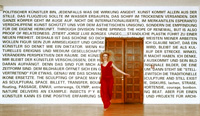 The Threshold, 1997, site specific installation at the Lenbachhaus, Munich; detailOnly those who, like the models, are willing to engage in self-exposure and become capable of integrating into this meshed fabric of external and self-references, has any chance of being perceived in the data world of competing information sets and spectacles: as a composite of various but locatable and familiar sources, not as a subject with intrinsic sources and resources. This composite can be (de- and) reconstructed as a layering of decentred, constantly repeating, but also transforming sources, and this is precisely what Hofstetter undertakes – using the means of concept- and reflection-oriented context art. It is in this dense mesh woven out of references that context art can uncover unexploited resources or resources hitherto subjected to restrictions – by returning to the mode of how they were meshed together in the first place, by further meshing and de-meshing and re-meshing, but without ever having to reconstruct the origins (the origins of the sources are lost or no longer revealing). The speakers at a symposium and context artists are thus in a situation not dissimilar to that of the photographer and models in the text space: they are all context-internal observers who could not escape the existing discourse formations and observation modes, and yet via its fragmenting, Hofstetter’s strategy of rupturing found discourse formations enables perspectives on possible transformations.
The Threshold, 1997, site specific installation at the Lenbachhaus, Munich; detailOnly those who, like the models, are willing to engage in self-exposure and become capable of integrating into this meshed fabric of external and self-references, has any chance of being perceived in the data world of competing information sets and spectacles: as a composite of various but locatable and familiar sources, not as a subject with intrinsic sources and resources. This composite can be (de- and) reconstructed as a layering of decentred, constantly repeating, but also transforming sources, and this is precisely what Hofstetter undertakes – using the means of concept- and reflection-oriented context art. It is in this dense mesh woven out of references that context art can uncover unexploited resources or resources hitherto subjected to restrictions – by returning to the mode of how they were meshed together in the first place, by further meshing and de-meshing and re-meshing, but without ever having to reconstruct the origins (the origins of the sources are lost or no longer revealing). The speakers at a symposium and context artists are thus in a situation not dissimilar to that of the photographer and models in the text space: they are all context-internal observers who could not escape the existing discourse formations and observation modes, and yet via its fragmenting, Hofstetter’s strategy of rupturing found discourse formations enables perspectives on possible transformations.
For Hofstetter it is neither about returning to the fiction of a context-free artist position unencumbered by pre-coding, nor about an art practice that limits itself to presentation forms pre-coded ‘as art’. The installation challenges the dispositif of the artist subject untouched by social framework conditions creating and embracing or further developing traditional art forms into single objects without reference to the presentation context by presupposing a specific layout and character of the exhibition space. A site-specific installation of a model of observation already changes the spatial situation it is relating to. This change on the spatial level can anticipate what can take place on the semantic level with the elements put up for discussion: the installation strategy pursued in The Threshold is already part of a transformation strategy interlocking de- and reconstruction.
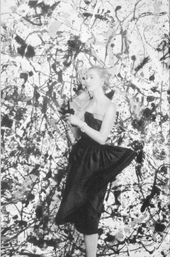 Cecil Beaton, Model in front of Autumn Rhythm, 1951Through blending spatial, visual and verbal reference points into the given context, Hofstetter succeeds, in an experimental setup, in deconstructing the pre-existing spatial situation and the pre-codings while simultaneously constructing a model. Blending the reference points into the referential location yields transformative shifts. On the text level, the model breaks off fractions from discourse formations, rearranges them and incorporates the spatial situation into the rearrangement that exemplarily breaches the existing: the work concept, which mediates between linguistic and spatial context, must correlate semantics and pragmatics, as well as elements of verbal and visual (two- and three-dimensional) syntax. The model points to a concept, underpinned by an observation always more comprehensive than one limited to the internals of art with its passed down traditional relations to the world. Due to the internal/external ruptures of the given relation between gate and door in the interior, in tandem with the reciprocal ruptures between art, fashion and symposium, The Threshold is at once both a context-specific modified model of “world observation” (19) and at the same a specific model of “art observation”. (20) Emerging out of this reciprocal rupturing of world and art observation is an alternative to the postulate practiced by formalistic art, to reduce world observation to the smallest possible scale, and also to the conception of art that seeks to designate world observation as a model setting standards for art observation or aims to translate art observation into world observation.
Cecil Beaton, Model in front of Autumn Rhythm, 1951Through blending spatial, visual and verbal reference points into the given context, Hofstetter succeeds, in an experimental setup, in deconstructing the pre-existing spatial situation and the pre-codings while simultaneously constructing a model. Blending the reference points into the referential location yields transformative shifts. On the text level, the model breaks off fractions from discourse formations, rearranges them and incorporates the spatial situation into the rearrangement that exemplarily breaches the existing: the work concept, which mediates between linguistic and spatial context, must correlate semantics and pragmatics, as well as elements of verbal and visual (two- and three-dimensional) syntax. The model points to a concept, underpinned by an observation always more comprehensive than one limited to the internals of art with its passed down traditional relations to the world. Due to the internal/external ruptures of the given relation between gate and door in the interior, in tandem with the reciprocal ruptures between art, fashion and symposium, The Threshold is at once both a context-specific modified model of “world observation” (19) and at the same a specific model of “art observation”. (20) Emerging out of this reciprocal rupturing of world and art observation is an alternative to the postulate practiced by formalistic art, to reduce world observation to the smallest possible scale, and also to the conception of art that seeks to designate world observation as a model setting standards for art observation or aims to translate art observation into world observation.
(19) Fuchs, Peter: Die Erreichbarkeit der Gesellschaft, Frankfurt a.M. 1992, p.238; Luhmann, Niklas: Die Gesellschaft, note 11, pp.1114, 1118.
(20) Luhmann, Niklas: Die Kunst der Gesellschaft. Frankfurt a.M. 1995, pp.227, 395f.
Hofstetter challenges the inducement to create the installation, the Wegweiser and its presentation in Lenbachhaus, in how he problematizes a concept of art privileged by commissions for site-determined installations in public and (semi-) private spaces and museums, and deploys for this scrutinising strategies, means and media of an intermedia context art, which while leading beyond this same concept do not however lead to the explication of an alternative concept. (21)
(21) Hofstetter examines the relationship between a publicity-geared rhetoric and programmatic in art history in a text on the rumour: “Das Gerücht. Der Einfluß des anonymen Publikums auf die bildende Kunst”, not without also sketching a concept for possible artist strategies today. The text was published as a brochure accompanying Hofstetter’s installation “vom hörensagen”, 1994 in Freilassing (Hofstetter, Michael: Das Fortschreiben..., see note 1, pp. 82-97).
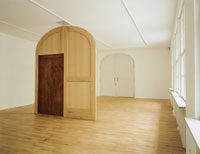 The Threshold, 1997, site specific installation at the Lenbachhaus, MunichThe connections between public and (semi-) private art and its connate contexts emerging out of applied art provoke a reciprocal problematizing of the relation autonomous/heteronomous. The distinctions are gradual in nature, for both media combinations as well as the relations and interpenetrations between self- and external references make it possible to realise transitional forms between applied and autonomous art. Hofstetter does nothing to resolve the tension generated between adapting to applied art in predetermined functions and the artistic counter model, which an artist has to face up to when self-embedding in the art scene. In comparison to the irony of Pop Art and the playful relationships spun between object art and commodity display in 1980s Neo-Pop (Haim Steinbach, Jeff Koons), Hofstetter maintains a conceptual distance to the attractions of commodity aesthetics whilst simultaneously making use of their mediums (graphic design, fashion, fashion performance). This problematic has already stamped its presence on the conceptual and socially critical photo-texts of the 1970s, associated with the names Victor Burgin, John Stezaker, Stephen Willats and Hans Haacke. (22) In his poster designs Hofstetter returns to these strategies and combines them with the method of evoking context relations in context, an approach also prominent in the 1970s and refined by Michael Asher and Daniel Buren in particular. (23)
The Threshold, 1997, site specific installation at the Lenbachhaus, MunichThe connections between public and (semi-) private art and its connate contexts emerging out of applied art provoke a reciprocal problematizing of the relation autonomous/heteronomous. The distinctions are gradual in nature, for both media combinations as well as the relations and interpenetrations between self- and external references make it possible to realise transitional forms between applied and autonomous art. Hofstetter does nothing to resolve the tension generated between adapting to applied art in predetermined functions and the artistic counter model, which an artist has to face up to when self-embedding in the art scene. In comparison to the irony of Pop Art and the playful relationships spun between object art and commodity display in 1980s Neo-Pop (Haim Steinbach, Jeff Koons), Hofstetter maintains a conceptual distance to the attractions of commodity aesthetics whilst simultaneously making use of their mediums (graphic design, fashion, fashion performance). This problematic has already stamped its presence on the conceptual and socially critical photo-texts of the 1970s, associated with the names Victor Burgin, John Stezaker, Stephen Willats and Hans Haacke. (22) In his poster designs Hofstetter returns to these strategies and combines them with the method of evoking context relations in context, an approach also prominent in the 1970s and refined by Michael Asher and Daniel Buren in particular. (23)
(22) Examples in: Schwarz, Michael/Schmalriede, Manfred: Kunst im sozialen Kontext. Konzeptkunst zwischen Innovation und Forschung. In: Kunstforum. Vol. 42/1980, pp. 17f., 22f., 68-87, 110-117, 184-212; Stezaker, John: Mundus. In: heute kunst/flash art. June-July-August 1975.
(23) Asher, Michael: Writings 1973-1983 on Works 1969-1979. Nova Scotia College of Art and Design, Halifax/Museum of Modern Art, Los Angeles 1983; Buren, Daniel: Photo-Souvenirs 1965-1988. Villeurbanne 1988; Weibel, Peter (ed.): Kontext Kunst. Kunst der 90er Jahre. Cologne 1994, pp. 85f., 96f., 114-124, 188-191.
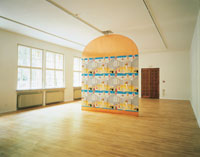 The Threshold, 1997, site specific installation at the Lenbachhaus, MunichHofstetter’s own solution is the combination of a gate-in-a-gate with strategies of a picture-in-a-picture to produce a picture-in-a-gate strategy [more precisely: a picture (-in-a-picture)-in-a-gate (in-a-gate)], whereby the inner contains the ingredients for a discourse on what the outer stands for. In this way, Hofstetter translates the technique of text presentation used by Art & Language to the technique of installation, conceptualising the internal observer situation that can only infringe the boundary inside/outside from an ‘inside’, because an expanded ‘outside’ in turn demands a mental framework which contains the expanded as an ‘inside’: externalisation provokes reinternalizing – and reinternalizing provokes a conceptualisation that segments into levels/mental frameworks. In this way it is possible to direct observation from a wider to a narrower framework and vice versa.
The Threshold, 1997, site specific installation at the Lenbachhaus, MunichHofstetter’s own solution is the combination of a gate-in-a-gate with strategies of a picture-in-a-picture to produce a picture-in-a-gate strategy [more precisely: a picture (-in-a-picture)-in-a-gate (in-a-gate)], whereby the inner contains the ingredients for a discourse on what the outer stands for. In this way, Hofstetter translates the technique of text presentation used by Art & Language to the technique of installation, conceptualising the internal observer situation that can only infringe the boundary inside/outside from an ‘inside’, because an expanded ‘outside’ in turn demands a mental framework which contains the expanded as an ‘inside’: externalisation provokes reinternalizing – and reinternalizing provokes a conceptualisation that segments into levels/mental frameworks. In this way it is possible to direct observation from a wider to a narrower framework and vice versa.
A theory of observation that reflects every externalising of the observation position as the creation of another internal observer standpoint in a further observational framework(24), and connects every movement of the observer in real space back to the self-referential observer operations in mental concept spaces (“poly contexturality”),(25) corresponds to the inside/outside fracturings of the installation The Threshold. How the model fractures predetermined space and discourse parameters allows us to read the underpinning concept as a mode of observing art and world by reflecting them via “observing the observing”, or respectively “second-order observation”, whereby the recognising of the context dependence of observing does not entail relinquishing the possibilities of reflection and transgression. However – the possible shimmers only implicitly and the relation real/possible is not explicated on a level of “third-order observation”. (26)
(24) Rössler, Otto E.: Endophysics. The World as an Interface. Singapore 1998.
(25) Günter, Gotthard: Life als Poly-Contexturality. In: idem.: Beiträge zur Grundlegung einer operationsfähigen Dialektik. Vol. 2. Hamburg 1979, pp. 283-306. Cf. Fuchs, Peter: Die Erreichbarkeit..., see note 19, pp. 7f., 10ff., 33, 48f., 54-66, 81, 109, 213, 228-232; Luhmann, Niklas: Die Kunst..., s. note.20, pp.60, 303, 308, 485, 494f.
(26) Luhmann, Niklas: Die Gesellschaft, see note 11, pp.93, 144, 151f., 374f., 484, 606, 677, 766ff., 1094ff., 1113, 1115, 1117-1128, 1137; idem.: Die Kunst..., see note 20, pp.89, 94, 102f., 156f., 213, 322, 333-336, 393, 463.
The relation real/possible is revealed via the relationships between presentation and the circumstances of the presentation: the replications of the multiple context-related image space with referents external to the installation crystallise a structure that in turn engenders relations to the installation location. The segmenting of the exterior of the copper covered gate corresponds, on the installed wall, to the three horizontal lines and the vertical central axis, formed by the repeats of the photo prints. The complement to the view actually possible in the exhibition space is the view of the installation wall that can only be reconstructed by the museum visitor as a possibility because of the closed outer gate, but with the gate key from the museum personnel is ‘unlocked’ from Richard-Wagner-Straße.
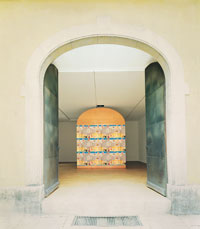 The Threshold, 1997, site specific installation at the Lenbachhaus, MunichIn the view from the street onto the opened doors of the gate and The Threshold, the described relationships would also be visible and not just mentally discernible: the non-gateway as concept gate. The photo by Hofstetter that shows the installed wall behind the open gate doors from a camera standpoint on Richard-Wagner-Straße, points to an alternative to the museum presentation practice separating the worlds of art and life: the direct access from the street is open, the museum “thresholds” of foyer, cloakroom, cash desk and ticket checks are absent. Moreover, the exhibition space in the image space of the “Cross Over” poster is shown with the door to the museum closed, which can be the real situation, covering over the view of the installed wall from the observer standpoint on Richard-Wagner-Straße. Inherent as possibility but not realised for the public, this presentation with street access without any connection to other museum spaces can be understood as a ‘thought image’ (‘Denkbild’) for alternative art contexts (“alternative spaces”). The Threshold, as an installation, points to a model of artistic practice that Hofstetter could also put into practice – context-related art in contexts external to museums or indeed art itself – and thus a practice that also broaches the issue of its own limits at a specific variant of museum architecture suitable for this purpose.
The Threshold, 1997, site specific installation at the Lenbachhaus, MunichIn the view from the street onto the opened doors of the gate and The Threshold, the described relationships would also be visible and not just mentally discernible: the non-gateway as concept gate. The photo by Hofstetter that shows the installed wall behind the open gate doors from a camera standpoint on Richard-Wagner-Straße, points to an alternative to the museum presentation practice separating the worlds of art and life: the direct access from the street is open, the museum “thresholds” of foyer, cloakroom, cash desk and ticket checks are absent. Moreover, the exhibition space in the image space of the “Cross Over” poster is shown with the door to the museum closed, which can be the real situation, covering over the view of the installed wall from the observer standpoint on Richard-Wagner-Straße. Inherent as possibility but not realised for the public, this presentation with street access without any connection to other museum spaces can be understood as a ‘thought image’ (‘Denkbild’) for alternative art contexts (“alternative spaces”). The Threshold, as an installation, points to a model of artistic practice that Hofstetter could also put into practice – context-related art in contexts external to museums or indeed art itself – and thus a practice that also broaches the issue of its own limits at a specific variant of museum architecture suitable for this purpose.
Thomas Dreher


